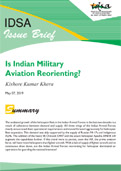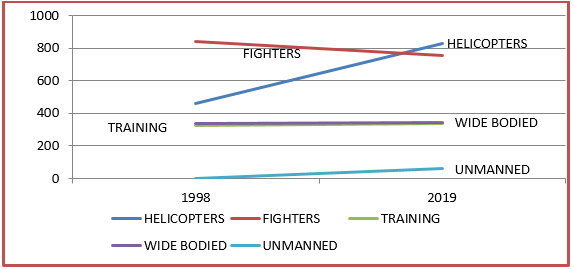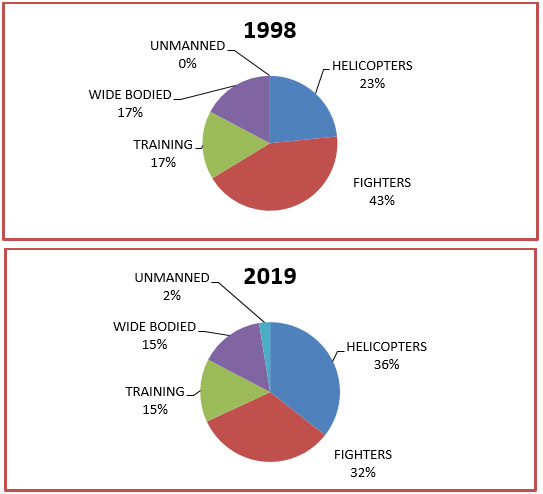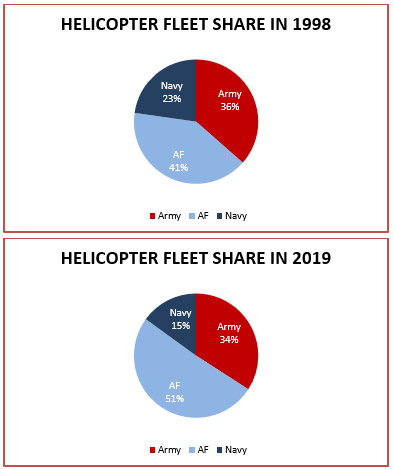You are here
Is Indian Military Aviation Reorienting?
 Aviation has been a part of military kinetic capability for over a century now. Exactly 100 years ago, for the first time, an independent military aviation wing was established that later was rechristened as the Royal Air Force of the United Kingdom.1 Based on the basic configuration of the lifting surface, aviation assets are broadly classified as fixed wing (aircraft) and rotary wing (helicopters). A further sub-classification in each category is based on their primary role. Fixed wing aviation assets include fighter aircraft of small size, with one or two crew members and primarily employed for weapon firing. The other subcategory of fixed-wing aircraft is the wide-bodied large aircraft capable of carrying passengers or cargo or special equipment like sensors or fuel. Training aircraft, another subcategory, includes normally very small and low-cost aircraft used for training pilots. For the rotary wing platforms, subclassification is blurred as each platform is normally capable of carrying out almost all tasks to varying degrees. In the last three decades or so, unmanned aircraft (Unmanned Aerial Vehicles (UAV)) have gradually created a space for themselves as a special subcategory in military aviation.
Aviation has been a part of military kinetic capability for over a century now. Exactly 100 years ago, for the first time, an independent military aviation wing was established that later was rechristened as the Royal Air Force of the United Kingdom.1 Based on the basic configuration of the lifting surface, aviation assets are broadly classified as fixed wing (aircraft) and rotary wing (helicopters). A further sub-classification in each category is based on their primary role. Fixed wing aviation assets include fighter aircraft of small size, with one or two crew members and primarily employed for weapon firing. The other subcategory of fixed-wing aircraft is the wide-bodied large aircraft capable of carrying passengers or cargo or special equipment like sensors or fuel. Training aircraft, another subcategory, includes normally very small and low-cost aircraft used for training pilots. For the rotary wing platforms, subclassification is blurred as each platform is normally capable of carrying out almost all tasks to varying degrees. In the last three decades or so, unmanned aircraft (Unmanned Aerial Vehicles (UAV)) have gradually created a space for themselves as a special subcategory in military aviation.
In most parts of the world, air forces are the primary custodians of military aviation assets, but land and maritime components of the armed forces also have aviation assets to meet their immediate operational requirements. In the Indian context, the Indian Navy (IN) and the Indian Army (IA) have sizeable aviation wings. The Indian Air Force (IAF) and the IN have assets in all subcategories (Fighter Aircraft, Wide Bodied Aircraft, Training Aircraft, Helicopters and UAVs), but the IA operates only helicopters and UAVs.
Expanding Hover Power
In the last two decades, the debate about Indian defence aviation has centred on the procurement of fighter aircraft for the IAF. Discussions in Parliament, arguments and counter-arguments in the Supreme Court, IAF strike at Balakot terrorist camp in Pakistan and reference to all these in the ongoing election campaign has kept the fighter aircraft for the IAF as the focal point. While the induction of Rafale in the IAF is still awaited after almost a two-decade-long procurement process,2 a substantial change has taken place in the rotary wing fleet of the Indian Armed Forces. In the last two decades, while the fixed wing assets of the three arms of the Indian defence forces have remained nearly static, their rotary wing strength has grown by over 80 per cent (see Figure 1).

Source: Based on data extracted from successive iterations of the IISS Military Balance from 1998 to 2019.3
Further, for the first time in the history of military aviation in India, the number of helicopters with the Indian Armed Forces exceeds the number of fighter aircraft (see Figure 2). There has been practically no change in the number of training aircraft and wide-bodied aircraft in the last two decades, but the fighter aircraft strength has been depleting. With the planned induction of more helicopters and the scheduled phasing out of several fighter aircraft on completion of their Total Technical Life/Calendar Life, this gap is likely to widen.4

Source: Based on data extracted from IISS Military Balance from 1998 to 20195

Source: Based on data extracted from IISS Military Balance, 1998 and 20196
The fighter aircraft share in military aviation assets has declined from 43 to 32 per cent since 1998 and during this period the share of helicopters has increased from 23 to 36 per cent (Figure 3). This indicates a lop-sided growth in military aviation assets.
Helicopters are a part of all three wings of the Indian Armed Forces. The helicopter fleet of the IN is primarily utilized on board ships for Anti-Submarine Warfare, logistics and communication. For the IA, the prime role of helicopters is observation and communication. However, the service has also been seeking a larger fleet with multiple capabilities including airlift and attack. Currently, Attack Helicopters on IAF inventory are under the operational control of IA. After a prolonged debate on the issue of control of helicopters, a decision was taken by the then Defence Minister A K Anthony authorizing IA to procure Attack Helicopters.7 However, medium and heavy lift helicopters remain under the sole control of IAF as of now.

Source: Based on data extracted from IISS Military Balance, 1998 and 20198
In the last two decades, the helicopter fleet has expanded in all three Services albeit at different rates. The least expansion of about 20 per cent is in the IN. The IA helicopter fleet expanded by over 70 per cent. But the most significant expansion in the helicopter fleet, over 126 per cent in the last two decades, has taken place in the IAF (Figure 4). As far as the inventory mix is concerned, like other aviation assets, helicopters continue to pose a major challenge. There are some commonalities between the three services in terms of older Chetak/Cheetah/Cheetal fleet and indigenous Advanced Light Helicopters (ALH), but overall the Indian military is already operating 12 different types of helicopters. 9 This number will go up with the various planned inductions. A wide variety and sources of helicopters will turn out to be a logistician’s nightmare for provisioning and result in huge financial outlays for spare stocking and setting up and operating maintenance facilities.
Whys and Wherefores
Operationally, helicopters play a vital role in communication, mobility, logistics and fire support. After the Kargil War in 1999, there has been a renewed focus on military capabilities that are essential for conflict in mountainous terrain.
Focus on Mountains. In the plains, improving infrastructure allows faster mobility and logistics support. However, in mountainous terrain, only helicopters can undertake inter-valley troop transfer and logistics operations to cut down mobility time substantially. Heli-lifting is the only option for heavy weapons and sensitive equipment in areas not connected with wide roads in the northern areas. Additionally, in conjunction with UAVs, helicopters can improve battlespace transparency tremendously, specifically in hilly terrain. All these make helicopters an essential ingredient of the Order of Battle in mountains. This has given rise to more demand and a consequent expansion of the helicopter fleet in the IA and the IAF.
Maritime Operations. With a growing economy, India’s dependency on Sea Lanes of Communications (SLOCs) has increased. This, accompanied by the forays of a number of extra regional players in the Indian Ocean, has led to Mission Based Deployment by the IN for protecting national interests.10 Helicopters, on board ships deployed on operational duty, play a pivotal role in ensuring the safe execution of the mission. As the Indian sphere of concern in the maritime domain increases, the number of IN ships on permanent deployment will increase. This warrants an increase in the number of helicopters for undertaking specialized operational roles. The helicopter fleet of IN is gradually expanding and will continue to grow along with its maritime fleet size.
Changing Character of War. In the last two decades, the probability of force-on-force warfare has reduced and hybrid war has become a reality.11 In such a scenario, special operations invariably are the first option to achieve national objectives. For these operations, helicopters provide an important option of insertion and extraction of small teams in the area of operation at high speed. Operation Geronimo to kill Osama bin Laden in Pakistan is a classic example in this category. Additionally, in urban warfare, owing to low speed, greater manoeuvrability and visibility and the option of directing weapon fire in multiple directions, helicopters have a greater role than high speed fighter aircraft. Therefore, there is a growing demand for armed and attack helicopters for kinetic force application.
Peace Time Operations. Helicopters are the most utilized military asset during peacetime. Owing to their ability to operate from open spaces with minimal infrastructure and ability to provide fast mobility, helicopters are extensively utilized in internal security operations, natural disaster relief operations and even to support elections by providing logistical support. A continuous demand on the military helicopter fleet for aid to civil power and its utilization in the national service has allowed fleet growth without bureaucratic hurdles.
Indigenous Supply. Development and manufacture of the indigenous Advanced Light Helicopter (ALH) by Hindustan Aeronautics Limited (HAL) has had the most profound impact on the supply of helicopters to the Indian Armed Forces. ALH, along with the Russian Mi-17, forms the backbone of the helicopter fleet in the armed forces. Such a supply chain is missing in the case of all other subcategories of military aviation assets. The result is obvious, and the helicopter fleet has almost doubled in the last two decades while all other subcategories are stagnant or depleting.
Implications
Aerial platforms capable of weapon delivery constitute the most significant component of combat air power. Besides fighter aircraft, armed and attack helicopters along with weapon delivery capable wide-bodied aircraft constitute this essential group. The number of attack helicopters in the Indian armed forces is less than five per cent of their total helicopter inventory. Although armed helicopters can augment attack helicopters, that can happen only under a benign air defence environment. All other aerial platforms are employed for combat support operations and most helicopter operations fall in this category. Quantitatively, as the helicopter fleet surpasses the fighter fleet, the force tends to have less combat power and expends more effort on combat support. The number of fighter aircraft per helicopter for the Indian armed forces has dropped since 1998 from 1.83 to 0.91. In contrast, this ratio for China stands at 2.01 and for Pakistan at 1.36. 12 This is a clear indication of military air power reorientation in India.
No doubt, additional helicopters provide mobility and logistic support at high speed and enhance the overall combat potential of deployed forces. In case they are employed in conjunction with high fidelity battle space transparency tools, helicopters can cut down the quantum of troops needed to be deployed for guarding the borders. Thus, helicopters provide a cost-effective solution to peacetime tasks. However, during hostilities, owing to their low speed and high radar, visual and acoustic signature, helicopters are vulnerable to surface-to-air weapons. Therefore, their employment must be planned well for safe and secure operations. Even a moderate threat from surface-to-air weapons precludes the employment of helicopters in the offensive role – a lesson the Indian Armed Forces re-learnt after the loss of a helicopter in the Kargil war in 1999. Helicopters are best deployed in a favourable air situation and when provided air cover by fighter aircraft against possible interception by hostile aircraft. A large fleet of helicopters operating over a vast area will need sanitization of the entire air space and an appropriate-sized fighter cover. Will this be possible with the Indian fighter fleet dwindling?
The increased number of helicopters would necessitate better and efficient air space management. The ability of the helicopter to fly very low and in the shadows of hills enhance its survivability but at the same prevents them from being picked up by friendly radars as well. Unless well-coordinated, the chances of fratricide increase. 13 To obviate such incidents, the entire area of operation needs to be kept under coordinated surveillance with multiple sensors located tactically.
A growing helicopter fleet would need greater allocation of financial resources for sustenance, maintenance and replacement. Within finite budgetary allocations, this will naturally come at the cost of some other capability. Unless a corresponding reduction is made in certain low priority capital and revenue expenditure, helicopter fleet expansion may result in cutting some other essential capability leading to an undesirable operational result.
The increase in the strength of helicopters needs to be viewed from the human resource aspect as well. Helicopters invariably have two pilots and an increase in the number of helicopters will result in an increased number of helicopter pilots. While in both IN and IA, aviation is a specialization for naval and army officers respectively, it is a core activity in the IAF. More than doubling of the strength of helicopters and alongside helicopter pilots in the IAF may lead to their stagnation – an undesirable outcome. As an example, of the five two-star appointments for aircrew in the Operations Branch at Air Headquarters, three compulsorily and one more invariably are manned by fighter pilots, leaving only one slot to be shared between transport aircraft pilots and helicopter pilots. In addition, both three-star appointments in this branch are exclusively manned by fighter pilots. Thus, practically, the senior-most positions manned by helicopter pilots in the Operations Branch at Air Headquarters are of one-star rank. The structure at the Operational Commands is also similar. Although IAF has had a helicopter pilot as its chief, that has happened just once so far. Such a skewed structure will have to change and be supported by a policy of recruiting a large number of helicopter pilots in the Short Service Commission who will serve the IAF for not more than 15 years. This will help reshape a steep pyramid structure.
Further Debate
The Indian Armed Forces have almost doubled their helicopter fleet in the last two decades. The trend is likely to continue for some more time. At this juncture, some issues that need to be debated are:
- Is the current organizational structure suitable to manage the growing helicopter fleet?
- For better operational management, should India be looking at a structure like the Joint Helicopter Command of the United Kingdom?
- Should India take a long-term view and rationalize the types of helicopters in the inventory to cut logistical and maintenance costs?
- Should India seek to balance military aviation assets within the allocated financial resources for maximizing combat air power?
Answers to these questions are essential to ensure that the capability build up plan of the Indian Armed Forces is suitable for the existing and emerging operational environment. Apparently, the motto of defence capital acquisition resulting in such a lop-sided growth has been “Grow, where possible” instead of “Grow, where needed”. While in the short-term this has helped tide over certain capability gaps, in the long run a balance between combat elements and combat support elements is mandatory. A synergetic and holistic approach in equipment acquisition would go a long way in optimizing the fleets by cutting down variety and sources. Aggressively pursuing “Make in India” is the best option.
Gestalt
The unabated growth of the helicopter fleet in the Indian Armed Forces in the last two decades is a result of coherence between demand and supply. All three wings of the Indian Armed Forces clearly annunciated their operational requirements and moved forward aggressively for helicopter fleet expansion. This demand was ably supported by the supply of Russian Mi-17s and Indigenous ALHs. The addition of the heavy lift Chinook CH4714 and the attack helicopter Apache AH64E15 will augment the capabilities further. Although some helicopter inductions and projects are running behind schedule, yet these are much faster than the induction and production plans for fighter aircraft. If this trend were to persist, soon the IAF, the prime aviation force, will have more helicopters than fighter aircraft. With a lack of supply of fighter aircraft and its continuous draw down, are the Indian Armed Forces reorienting for helicopter dominated air operations for guarding the national interests?
Views expressed are of the authors and do not necessarily reflect the views of the IDSA or of the Government of India.
- 1. RAF 100, available at https://www.raf.mod.uk/our-organisation/raf100/, accessed on May 2, 2019.
- 2. Bikash Singh, “Air force will have first Rafale jets by 2019: Air Chief Marshal Dhanoa,” The Economics Times, November 29, 2018, available at /economictimes.indiatimes.com/news/defence/air-force-will-have-first-rafale-jets-by-2019-air-chief-marshal-dhanoa/articleshow/66866157.cms, accessed on May 2, 2019.
- 3. International Institute of Strategic Studies (IISS), Military Balance, 1998 to 2019, London: Routledge, Chapman and Hall, 1998–2019.
- 4. Report of Standing Committee On Defence (2017-2018) (Sixteenth Lok Sabha), Ministry of Defence Demands for Grants (2018-19) Army, Navy and Air Force (Demand no. 20), presented to Lok Sabha on March 13, 2018.
- 5. IISS, Military Balance, 1998–2019, London: Routledge, Chapman and Hall, 1998–2019.
- 6. IISS, Military Balance, 1998–2019, London: Routledge, Chapman and Hall, 1998–2019.
- 7. Vinay Kumar, “Army to get Control of Attack Helicopters,” The Hindu, October 13, 2012, available at https://www.thehindu.com/news/national/Army-to-get-control-of-attack-helicopters/article12555177.ece, accessed on May 2, 2019.
- 8. IISS, Military Balance, 1998–2019, London: Routledge, Chapman and Hall, 1998–2019.
- 9. IISS, Military Balance, 1998–2019, London: Routledge, Chapman and Hall, 1998–2019.
- 10. Indian Navy Website, available at https://www.indiannavy.nic.in/content/mission-based-deployments, accessed on May 4, 2019.
- 11. Vikrant Deshpande, ed., Hybrid Warfare: The Changing Character of Conflict, Pentagon Press, New Delhi, 2018.
- 12. Based on data extracted from IISS, Military Balance, 1998–2019, London: Routledge, Chapman and Hall, 1998–2019.
- 13. See Manu Pubby, “Budgam: Indian missile fired before Mi17 V5 chopper crash,” The Economics Times, April 1, 2019 available at https://economictimes.indiatimes.com/news/defence/budgam-indian-missile-..., accessed on May 4, 2019.
- 14. Press Release, Indian Air Force, “Induction of Chinook Helicopters in Indian Air Force,” March 25, 2019, available on http://indianairforce.nic.in/content/induction-chinook-helicopters-indian-air-force, accessed on May 4, 2019.
- 15. Shiv Aroor, “Boeing-made AH-64E Apache attack helicopters to join IAF fleet in ’19,” India Today, July 28, 2018, available on https://www.indiatoday.in/mail-today/story/boeing-made-ah-64e-apache-attack-helicopters-to-join-iaf-fleet-in-19-1298619-2018-07-28, accessed on May 4, 2019.
| Attachment | Size |
|---|---|
| 377.59 KB |


